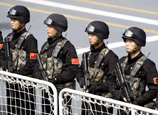
 |
| Leanne Claxton's works on fabric give fans an affordable collection. (Photos/China Daily) |
Besides being able to integrate more colors into one design, digital printing is also better suited than screen printing for small orders and customized designs based on things like paintings, photographs and collages. In the more traditional screen printing, or silk-screening method, dye is squeegeed onto fabric through screens containing design stencils, one color at a time.
On the Chinese mainland, digital fabric printing, a growing industry that started in the mid-'90s, is also considered more eco-friendly.
It doesn't cause pollution or release harmful substances into the environment, says Jia Jingsheng, a professor at Tsinghua University's Academy of Art and Design, who specializes in textiles and dyeing.
Dyes used in traditional printing need to be "fixed" by metallic solutions, which when drained into the soil are harmful because they accumulate and become toxic to humans and animals, says Anita Quye of the University of Glasgow's Center for Textile Conservation and Technical Art History.
Digital fabric printing, Jia says, saves on resources, such as the multitude of stenciled screens needed in screen printing, as well as the dyes left over in the squeegeeing process.
But at the same time, he says, it has led to ink-safety issues in the industry.
"A lot of inks contain excessive amount of heavy metals that pose a definite threat to human health," Gong, a member of the All-China Environment Federation's research committee on environmental protection standards, says in an e-mail.
Official random testings of Chinese digital print clothing, he says, have repeatedly detected the presence of elements like arsenic, mercury, lead and manganese.
"Some were almost a hundred times more than the acceptable level, so there's still a big hidden danger when it comes to garment safety."
Since 95 percent of ink used in the domestic digital print industry is imported, Gong says it's imperative that China sets product standards that promote sustainability. Ink-exporting countries, he says, have rigid standards for the products they consume, but have lower standards for inks sold to China.
Claxton, whose digital prints are manufactured in her native England, as well as Hong Kong, Shanghai and Hangzhou, was surprised to hear about Gong's findings.
"I've never seen anything in the (Chinese) factories that look different from when I'm in the UK factory," she says. "I took samples when I went back home in the summer, and I said, 'Look, this is what I'm getting from my Chinese factories.'
"In fact, on one specific fabric base, the UK factory said they couldn't achieve the same print level," Claxton says. "I can't complain, really."
And in such a new design field in China, changes are bound to happen every day.















 Sex case leads to warnings about apps on smartphones
Sex case leads to warnings about apps on smartphones


![]()
